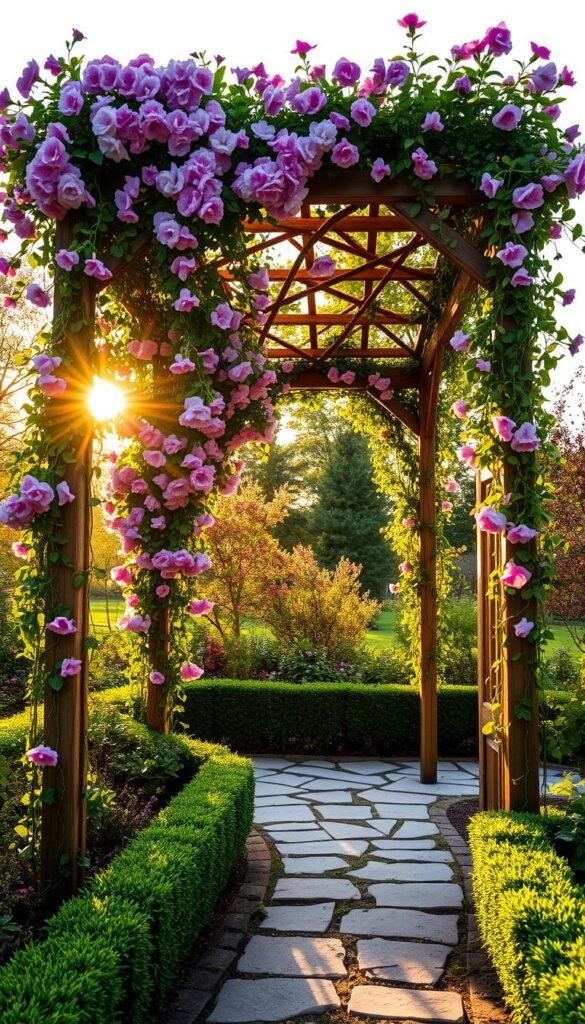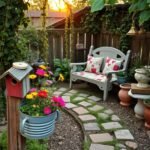Your yard becomes more inviting when you blend practical support systems with artistic touches. Structural elements like climbing frames and walkways turn plain areas into dynamic environments where plants thrive and people linger. Craiger Custom Design notes these features act as both plant supporters and decorative statements, offering flexibility for any landscape.
Imagine morning glories winding up bamboo poles or grapevines cascading over metal arches. These installations boost vertical growth while creating natural privacy screens. They also help organize your layout – guiding foot traffic along stone paths or separating vegetable patches from relaxation zones.
Materials matter as much as purpose. Wood brings rustic warmth, while powder-coated steel withstands harsh weather. For small areas, DIY trellis projects using repurposed items like old ladders maximize space without overwhelming it. Even basic structures become eye-catching when draped with blooming vines.
Whether you prefer minimalist lines or intricate patterns, these additions transform how you experience your property. They turn functional needs – like supporting heavy wisteria – into opportunities for creative expression. Your outdoor area gains depth, texture, and year-round appeal through smart structural choices.
Transform Your Outdoor Space with Captivating Garden Pathways

Pathways serve as the backbone of your outdoor design, blending practicality with visual storytelling. A well-planned route doesn’t just connect points – it invites discovery and frames your favorite plants like living artwork.
Designing a Welcoming Entryway
Start with curves rather than straight lines to spark curiosity. Gentle bends create natural pauses where visitors can admire your landscape. For main routes, keep widths around 48 inches – enough for two people to walk side-by-side comfortably.
Narrower secondary paths (24-36 inches) work well for hidden seating nooks or herb gardens. Use edging materials like river rocks or dwarf boxwoods to define borders. This prevents gravel or mulch from spilling into planting zones while adding crisp lines to your design.
Selecting Materials for Long-Lasting Beauty
Match your home’s style with these durable options:
- Flagstone: Natural texture that ages gracefully
- Permeable pavers: Eco-friendly solution for rainy climates
- Decomposed granite: Budget-friendly with rustic appeal
Prep the ground properly – dig 6-8 inches deep, layer crushed stone for drainage, and tamp firmly. For low-maintenance spaces, consider resin-bound gravel that stays weed-free. Add solar-powered lights along edges to highlight your gardening aesthetic after sunset.
Remember: Your pathway materials should handle foot traffic while complementing nearby features. A brick walkway pairs perfectly with traditional homes, while sleek concrete suits modern landscapes. Let your surface choice tell part of your garden’s story.
Beautiful Flower Garden Upgrades: Pathways, Trellises, and Archways

Architectural elements in your landscape do more than hold plants – they craft visual rhythm and define spaces. Thoughtful trellis and arch designs turn functional needs into artistic statements, whether framing a seating area or guiding vines skyward.
Key Features of Stunning Trellis and Arch Designs
Successful structures balance plant needs with style. A wisteria-covered arch needs heavy-duty metal framing, while morning glories thrive on lightweight bamboo grids. Always match your support system to the plant’s growth habits and weight.
Material choices shape both durability and mood. Rustic cedar complements cottage-style spaces, while powder-coated steel suits modern landscapes. For inspiration, explore these gorgeous arch and trellis concepts that blend form with function.
| Material | Best For | Considerations |
|---|---|---|
| Wood | Traditional designs | Requires annual sealing |
| Metal | Modern landscapes | Rust-proof finishes needed |
| Bamboo | Tropical themes | Replace every 2-3 years |
| Wrought Iron | Formal structures | Heavy-duty anchoring required |
Proportions matter most. A 7-foot arch creates dramatic entryways without overwhelming small yards. For narrow spaces, lean-to trellis designs save room while supporting climbers. Always leave clearance for pruning and plant growth.
Winter visibility matters too. Bare structures should still enhance your space – intricate metalwork or geometric patterns add interest when plants retreat. Pair evergreen vines with deciduous varieties for year-round coverage.
DIY Trellis Projects: From Simple to Advanced Creations

Personalizing your outdoor space doesn’t require deep pockets – just creativity and basic materials. These DIY trellis ideas let you support climbing plants while adding unique character to your landscape.
Simple DIY Trellis Ideas for Beginners
Start with a classic teepee design using three poles tied at the top. Wrap wire horizontally between the poles to create climbing surfaces for beans or peas. This budget-friendly option takes under an hour to build.
Wire mesh panels offer another quick solution. Attach them to fence posts or walls for instant vertical growing space. Morning glories and clematis will transform these simple grids into living art.
Creative Upcycled and Repurposed Options
Old curtain rods become elegant wall-mounted supports for ivy. Antique wagon wheels make striking circular frames when secured to posts. Even rusty bed springs gain new purpose as quirky climbing structures.
Consider these durable repurposed pieces:
- Bicycle frames as arched supports
- Expandable coat racks as adjustable trellises
- Vintage garden tools as decorative plant guides
Bamboo sticks tied with twine create temporary structures perfect for renters. Their natural look blends seamlessly with climbing plants while remaining easy to disassemble.
Material Matters: Wood, Metal, Bamboo, and Beyond
Your choice of materials shapes both the lifespan and personality of your landscape features. Each option brings unique strengths – from weather resistance to visual harmony – that impact how your space evolves over time.
Comparing Durability and Aesthetic Appeal
Wood remains the go-to for many homeowners. Its natural texture blends with plants effortlessly, and you can customize it with basic tools. Cedar and redwood offer rot resistance, while pine provides budget-friendly versatility.
Metal designs have evolved beyond basic grids. Powder-coated steel arches now double as standalone art pieces. These withstand heavy winds but need rust-proof finishes in coastal areas. For modern homes, sleek aluminum frames create crisp lines.
Bamboo stands out for eco-conscious projects. Its lightweight poles assemble with simple knots – no power tools required. Though less durable than metal, it’s perfect for temporary setups or tropical themes. Pair it with fast-growing annual vines for quick coverage.
| Material | Lifespan | Maintenance | Style Match |
|---|---|---|---|
| Wood | 5-15 years | Annual sealing | Cottage, rustic |
| Metal | 20+ years | Rust prevention | Modern, industrial |
| Bamboo | 2-5 years | Seasonal replacement | Tropical, casual |
| PVC | 10+ years | Occasional cleaning | Custom color schemes |
PVC offers unique advantages for rainy climates. These lightweight structures won’t warp or splinter. Paint them to match your home’s trim color for cohesive design. They’re ideal for heavy flowering vines that need sturdy support.
Consider your local climate when choosing. Humid regions demand rust-resistant metals, while arid areas benefit from UV-stable plastics. Balance upfront costs with long-term care needs – sometimes spending more now saves replacement work later.
Innovative Archways and Pergolas for Elevated Garden Areas

Create living ceilings and natural dividers that redefine how you use your yard. These architectural elements transform overlooked spaces into functional art, blending plant support with visual storytelling. Archways and pergolas add vertical interest while solving practical challenges like shade needs and space division.
Maximizing Space with Arched Designs
An arched gateway isn’t just for entrances. Position one between seating areas to create intimate zones without walls. Rose-covered arches make perfect room dividers – their thorny stems naturally discourage foot traffic through flower beds.
Modern pergolas take this concept further. “These structures act as outdoor ceilings,” notes a landscape architect from Houzz. “They define dining spaces while letting vines filter sunlight.” Adjustable louvers and built-in lighting extend their use into evening hours.
For tight spaces, curved designs work wonders. A 6-foot arch over a narrow walkway creates vertical impact without eating up precious square footage. Pair it with fast-growing clematis for quick coverage that softens hard lines.
Consider these space-smart solutions:
- Double-duty pergolas that support plants and hang string lights
- Modular arch systems connecting multiple garden zones
- Slender metal frames doubling as art installations in winter
Quality materials ensure decades of service. Powder-coated aluminum withstands harsh weather, while cedar develops a silvery patina that complements mature plantings. These investments boost curb appeal while creating cherished outdoor retreats.
Planting and Pruning: Tips for Climbing Plants and Vines

Timing your plantings and pruning techniques makes all the difference for thriving vertical gardens. By aligning your care routine with seasonal rhythms, you’ll enjoy lush growth and vibrant displays that evolve throughout the year.
Seasonal Planting Strategies for Trellises
Cool-season stars like sugar snap peas and snow peas establish quickly in early spring. These fast growers provide temporary coverage while warm-season favorites like cherry tomatoes and pole beans mature. For summer heat, try Armenian cucumbers or luffa gourds – they’ll climb vigorously when temperatures soar.
Evergreen options like star jasmine keep structures attractive year-round. Their fragrant flowers add sensory appeal even in cooler months. Remember: ornamental sweet peas offer stunning spring blooms but contain toxic compounds – admire their beauty without tasting.
Maintaining Healthy Growth Throughout the Year
Prune aggressive growers like wisteria hard in late winter to control size. Delicate clematis vines need gentle shaping after their first bloom. Always use clean, sharp tools to prevent disease spread.
Follow this seasonal care rhythm:
- Spring: Train new shoots with soft plant ties
- Summer: Remove spent flowers to encourage reblooming
- Fall: Clear dead foliage to deter pests
Regular monitoring helps catch issues early. Check for aphids on new growth and adjust watering as temperatures change. With smart timing and proper care, your vertical garden becomes a living masterpiece.
Enhance Your Garden Design with Artistic Accents and Lighting
Turn functional spaces into visual stories by blending sculptural metalwork with strategic illumination. Welded pieces like abstract trellises or geometric screens become standalone art installations that captivate even without climbing plants. Hunt for these unique finds at local markets or commission custom designs to reflect your backyard’s personality.
Metal creations anchored to fences add texture and depth to your landscape. Their intricate patterns cast dramatic shadows when sunlight filters through, while winter frost highlights their structural beauty. For rustic charm, repurpose old farm tools or salvaged ironwork into one-of-a-kind supports.
Lighting amplifies these artistic touches. Soft LED strips under benches wash walls with warm glows, making evening strolls magical. Solar-powered spotlights angled at textured surfaces create depth, while string lights woven through metal frames add whimsy.
Play with color by painting supports in bold hues that pop against greenery. Deep blues make white jasmine blooms shine, while copper finishes develop a patina that evolves with seasons. Your backyard becomes an ever-changing gallery where light and art work in harmony.






